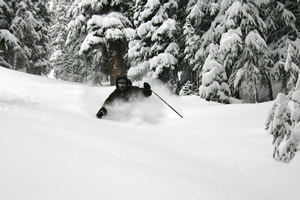
Courtesy of Casey Day
- Recent town of Vail community survey identifies parking as top issue for townies
- Vail Christian High School board buys back bonds, rescues next school year
- Vail Resorts to host Lindsey Vonn celebration in Vail Wednesday, March 31
- Vail Resorts Epic Pass, Summit Pass available through November 30, 2009
- 9 candidates, including 3 incumbents, running for 4 Vail Town Council seats Nov. 3
- Nominating petitions for four open Vail Town Council seats available Sept. 14
- Eagle County commissioners to vote Tuesday on temporary marijuana dispensary regulations
- Vail Town Council rejects ballot question to change council terms
- Polis defends health-care reform at packed town hall in Edwards
- Vail blaze illustrates need for defensible space, roadless rule changes, state says
- All Real News Articles
January 25, 2009 — For most Front Range skiers and snowboarders, the morning routine goes something like this: Wake up early, pour coffee, check snow report and go.
And while some might argue that caffeine is the most critical element to starting your ski day right, in this age of multi-mountain season passes, it’s the snow report that often dictates where you go. So where does the snow report come from? And does 12 inches at Arapahoe Basin equal a foot of fresh in Winter Park?
“We have suggested guidelines that we ask all our member resorts to follow in order to maintain consistency,” said Jennifer Rudolph, spokeswoman for Colorado Ski Country USA, an umbrella organization that aids in marketing, communications, public policy — and snow reporting — for 22 of the state’s ski resorts.
“The means of measurement differ some from resort to resort. Some use sonar, others have the old-fashioned stick in the snow. But we feel like they all do their best to get us accurate information.”
Snow accumulation totals are submitted to CSCUSA twice a day, at 5 a.m. and 1 p.m. That information is then posted on the organization’s Web site — www.coloradoski.com — and sent via e-mail to snow-report subscribers. Both reports include 24-hour, 48-hour and current mid-mountain base depth totals.
Vail Resorts, which severed its ties with CSCUSA in May, operates Vail, Beaver Creek, Breckenridge and Keystone and produces its own four-area report.
“Even though we’re not part of that organization anymore, we still abide by their guidelines,” said Ryan Whaley, Breckenridge spokesman. “It’s not something you want to exaggerate.”
Measurements are taken in areas known as “snow plots,” which are located mid-mountain in places protected from wind and away from skier traffic.
“You don’t want the snow to get blown off, and you don’t want to measure a snow drift,” said Leif Eric Borgeson, Arapahoe Basin’s snow safety director. “Our site has two sonar mechanisms, one to measure total base and one for new accumulation that gets cleared by ski patrol every day.”
The set-up is similar at the four Aspen area resorts, except theirs clear automatically.
“Basically, you have one snow station that is shooting sonar down to the ground and bouncing it back up to get a base depth reading,” said Jeff Hanle, spokesman for Aspen/Snowmass. “The other does the same thing on what’s called a ‘storm board’ — just think a flat board — that sits there and collects the snow. Every 24 hours, it flips over automatically, dumping the snow and starting over. We download that information via phone line and can see hour by hour how much snow has fallen.”
It’s a far cry from days past, when, according to Hanle, the snow report came courtesy of a night-time snow-cat driver who simply took a ruler measurement and called it in.
Despite the advances in technology, the snow-report system is not perfect. Most resorts don’t provide anything less than a 24-hour report, meaning if a storm dumps 6 inches early in the day and then peters out, the next day’s report will say 6 new inches in the last 24 hours even though it’s likely that new snow has long since been skied off.
“There’s no doubt that an overnight number would be valuable, but it would have to be industrywide and you’d have to add another storm board,” said A-Basin’s Borgeson.
Aspen’s Hanle suggests when in doubt, pick up the phone.
“The Internet and e-mail reports are limited because you’ve got to put numbers into pre-set fields,” he said. “But when I record the phone report, I can say, ‘We’ve had X amount of inches in the last 24 hours, including Y overnight. That way you get the best overall picture of what the conditions are going to be like.”
[Editor’s Note: This story originally appeared in the Boulder Daily Camera newspaper.]
![]() Comment on "No snow, sonar or so gnarly: Making the most of the modern snow report" using the form below
Comment on "No snow, sonar or so gnarly: Making the most of the modern snow report" using the form below












